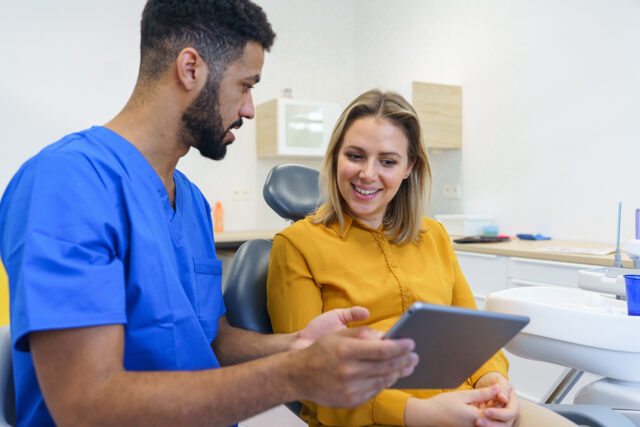Even with all of the technological advances in our modern healthcare offices, many of your patients’ first experience with your office will be on the telephone. Because of this, it’s critical that front office staff use excellent etiquette when speaking to patients or potential patients on the phone. This level of professionalism can make an enormous difference in how you are seen by current or future patients.
Rules of Phone Etiquette
These are pretty simple, but being aware of them goes a long way toward providing excellent service and ensuring a positive patient experience.
Rule #1: Speak Loud and Clear
If you use a traditional phone and handset, be sure that you’re speaking directly into the mouthpiece. This ensures that your voice carries clearly through the line and ensures the person on the other end that you are paying attention and ready to assist them. If it’s important to have both hands free while answering the phone, consider purchasing a headset rather than propping the handset on your shoulder.
Rule #2: Acknowledge Incoming Patients
If someone comes into your office while you’re on the phone, acknowledge them with a polite smile or nod, then finish your call. If the call seems as if it may go longer, ask the caller if you may put them on hold briefly. Always wait to hear the caller’s answer before before actually pushing the hold button. Handle the in-person interruption, then return promptly to your caller.
Rule #3: Keep Hold Time Brief
If you place a patient on hold, be sure to check back within 30 to 45 seconds so the caller knows you haven’t forgotten them. Never lay a handset or headset on the counter without asking to place the caller on hold and then pressing the hold button. Along with potential HIPAA violations, as callers may be able to hear sensitive patient information, it’s just rude to do this. And always remember to thank a caller for holding.
Rule #4: Be Cheerful and Professional
When you answer the phone, use a cheerful, professional greeting which identifies the office and who you are. For example, “Thank you for calling Mountain Vision Clinic, this is Julie. How may I help you?” It’s good to avoid saying “good morning,” or “good evening” as it’s easy to confuse the time of day during a busy workday. Whatever greeting you choose, your patient should hear a pleasant, professional tone in your voice.
Rule #5: Stay Calm
Regardless of the caller’s tone of voice, sounding pleasant and professional is one of the most important parts of your job if you are charged with answering the phones. When a patient is angry or frustrated, it’s important to remember that their emotions aren’t personally directed. View each call as an opportunity to solve a problem or make someone feel better than they did when they called in initially. Gather as much information as you can to help address the caller’s concern.
Rule #6: Get Important Info for All Call Backs
If you have to refer the call to someone else, be sure to explain to your patient whom you are transferring the call to and why, and thank them for their patience. It may be necessary to have someone call the patient back at a later time. Be sure to get all the necessary information, such as phone numbers (both cell phone and home or work numbers), the details of the issue, the date and time of the original call, and anything else you believe might be helpful for someone assisting that patient.
Rule #7: End Your Calls Courteously
When it’s time to say good-bye to the caller, it can get a little awkward. Try to give a final statement that indicates you’re about to end the call.
For example, “Thank you for bringing this to our attention. We’ll address it with our staff immediately.” Or, “I’m glad you called to reschedule. We’ll see you on Thursday at 9:00.” When the caller has agreed, follow up with, “Thanks for calling. Good-bye.” Don’t use, “okie-dokie” or “alrighty” or any other slang phrase to end the call. They aren’t professional and they don’t close the call on a courteous note.
It takes very little to sound professional and polite on the phone. Following these simple guidelines ensures that all your patients, existing or potential, have a favorable first impression of your office and your staff.
For more tips on keeping your office patient friendly, checkout our free checklist.



